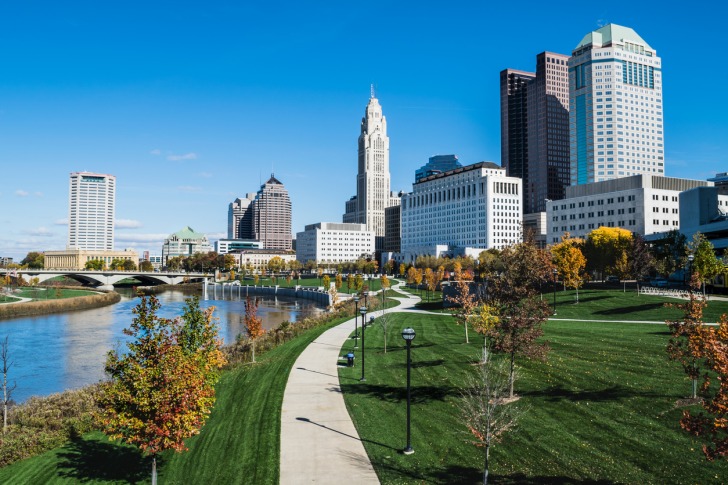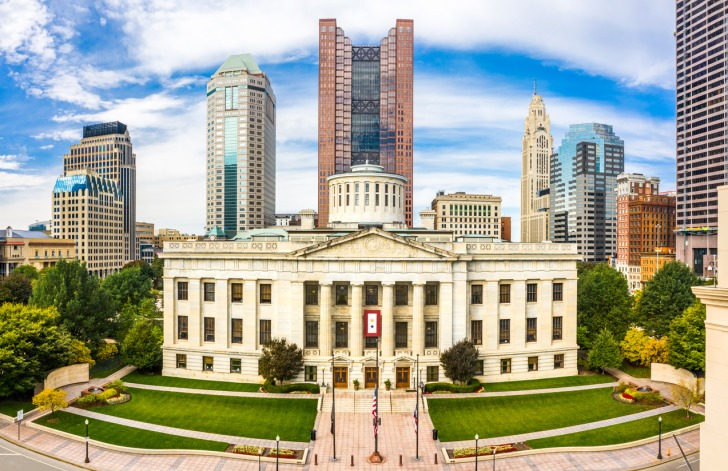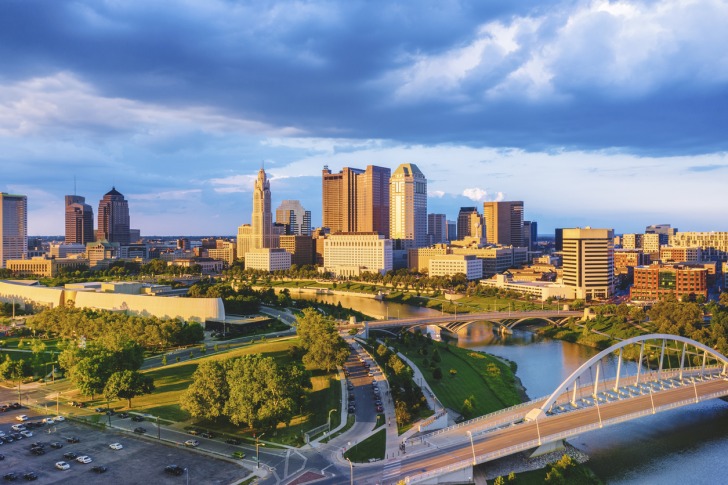Columbus is the capital city of Ohio and the county seat of Franklin County.
The city assumed the role of being the state capital in 1812.
It started with gradual growth until it exploded into the large, highly populated city that it is today.
The many amenities of the city are primary factors when some people consider moving to the city.
All cities have pros and cons, and it is important to consider the pros and cons of living in Columbus, Ohio before moving to the area.

Contents
Pros of Living in Columbus, Ohio
1. Low Unemployment Rate
The unemployment rate in Columbus is lower than the national average.
It is also lower than the state average.
Ohio’s unemployment rate for September 2023 was 3.4 percent.
The U.S. Bureau of Labor Statistics indicates that the national unemployment rate was 3.8 percent.
The unemployment rate for the civilian labor force in Columbus, Ohio in September 2023 was 3.2 percent.
2. Efforts to Revive Inner-City Neighborhoods
The city leaders in Columbus recognize that there are several neighborhoods that need an update.
Franklinton was the area where the first residents lived when they moved to Columbus.
The neighborhood became known as a blighted, high-crime, and high-drug area several years ago.
Efforts are underway to revitalize Franklinton, with plans to demolish or remodel empty houses, and to reduce drugs and crime.
The west side of Columbus is an area where revitalization efforts are underway.
Closing problem businesses and apartment buildings is one way to reduce some neighborhood issues, and to bring new residents to the neighborhood.
3. Affordable Housing
Columbus has plenty of affordable homes and rental properties.
Residents who want to purchase a home are happy to know that the median value of owner-occupied homes is $174,400.
The neighborhood where residents live affects their housing costs.
Living within the city limits is less expensive than living in areas such as Upper Arlington, where the median home listing price is more than $572,000.
The cost of an apartment rental also varies considerably based on the location of the property.
Residents find a rental property for less than $800 a month in some areas of Columbus, Ohio.
Living in Downtown Columbus, or in upper-income areas means that renters pay more for their apartment or rental home.
Apartment rentals cost residents more than $2,000 a month in some areas.
4. Location, Location, Location
Columbus, Ohio is in a location that is central to the rest of the country.
It is a one-hour flight or a one-day drive to almost 50 percent of the U.S. destinations.
Downtown Columbus is just 10 minutes away from John Glenn International Airport.
Residents can easily commute to other areas for business or pleasure.
The location of the city may be one reason that so many companies and entertainment venues choose Columbus for their business and leisure activities.
5. Population Diversity
The diversity of the population in Columbus is an important factor for people who prefer to live in an area that is known for its diversity.
The population is 53.8 percent white, and 29.2 percent black or African American.
Columbus, Ohio has a large Somali population.
There is also an estimated 6.5 percent of Columbus residents who are Hispanic.
The U.S. Census Bureau indicates that 5.8 percent of the population is Asian, and 5.8 percent of the Columbus population who identifies as being of two or more mixed races.
6. Things to See and Do
There is always something to see and do in Columbus.
Singles, couples, and families looking for kid-friendly activities are sure to find an ideal place or event.
The Columbus Zoo and Aquarium has a great reputation for its conservation efforts, the more than 600 species and 10,000 animals at the zoo.
More than two million people visit the zoo each year.
Zoombezi Bay is next to the zoo.
Visitors can purchase a ticket to enjoy both the water park and the zoo all in one day.
The Center of Science and Industry (COSI) is a great place to take kids, from infants to teens.
Enjoy the state’s largest planetarium, the giant theater screen, and more than 300 exhibits and hands-on activities.
The Columbus Museum of Art features many famous works.
The Franklin Park Conservatory and Botanical Gardens boasts the world’s largest collection of Chihuly Glass.
The Conservatory features fun and educational exhibits for every season.
The Short North Arts District is a vibrant community for the arts and business.
The University District features a variety of restaurants, from fast food to fine dining locations.
The University District and Short North are the choices of many Columbus residents for their nightlife experiences.
Visit German Village.
It is a neighborhood built by German settlers several hundred years ago.
Stroll or jog along the Scioto Mile.
Enjoy the city and more than 250 acres of parkland in Downtown Columbus.
7. Job Market
Columbus has a booming job market.
The city is home to more than 20 Fortune 1000 companies.
Ohio State University is one of the city’s largest employers.
Government, healthcare, professional and business services, and retail are some other major employment sectors in Columbus.
The future Columbus job market is expected to grow faster than the national average.
8. Educated Population
Residents of Columbus have their choice of which college to attend, based on their interests and goals.
Ohio State University brings students from around the globe to its campus locations.
The 2023 enrollment included more than 51,000 undergraduate students and more than 11,000 graduate students.
The Columbus College of Art and Design, Franklin University, and Capital University are some other area colleges.
More than 90 percent of the residents in Columbus are high school graduates.
Nearly 40 percent of residents have a bachelor’s degree or higher education.
Cons of Living in Columbus, Ohio
1. High Property Tax Rate
The median real estate taxes paid in the U.S. in 2021 was $2,971, with the tax rate being 1.11 percent.
Ohio’s residents pay a median real estate tax rate of 1.57 percent.
Columbus, Ohio residents pay a median property tax rate of 1.67 percent of the assessed fair market value of their property.
2. Population Density
The city of Columbus has an urban feel.
Columbus is the largest city by population, with more than 905,000 residents, as of 2020.
The city’s growth rate is expected to continue, with the current annual growth rate being 1.28 percent.
There are an estimated 4,300 people per square mile living in Columbus.
3. Traffic Congestion and Bad Drivers
Bad drivers contribute to traffic congestion and the need for Columbus residents to pay constant attention to other drivers around them.
Some areas of the city are worse than others for traffic congestion.
Expect congestion on Route 315, especially during popular class times at Ohio State.
It is the main exit area to get to campus.
North High Street is a heavily trafficked road, even when it is not because of students trying to get to and from classes.
The downtown area often has congested areas, especially in the Arena District, when there are popular events at Nationwide Arena.
4. Weather Woes
Columbus is not the ideal location for great weather and climate.
The hottest month in Columbus is July when the temperature averages 85 degrees Fahrenheit during the daytime.
The coldest month is January, where the daytime average high temperature is 20 degrees.
There is an average of 133 days per year that Columbus has precipitation.
The average annual precipitation is 56.11 inches.
The precipitation may not be a delight for Columbus residents, but the mosquitoes and other bugs seem to enjoy it.
5. Allergies
People who have seasonal allergies may need to keep their tissues and preferred allergy treatment close by when they live in the Columbus area.
The many varieties of trees and other vegetation likely contribute to the city’s many days with high pollen counts.
The spring and fall seasons are likely the worst months for Columbus residents who have allergies.
6. Crime Rate
Columbus gets low grades and ratings for its high crime rate.
The violent crime rate is higher in Columbus, compared to the state average for several types of crimes.
The number of murders, rapes, robberies, and burglaries is much higher than the state average.
The violent crime rate in Columbus is also higher than the national average.
Columbus had 86 murders per 100,000 residents in 2019.
That number skyrocketed to 174 murders per 100,000 residents in 2020.
The number of assaults that occurred in Columbus in 2019 was 1,800 per 100,000 residents.
Columbus had 2,279 assaults per 100,000 residents in 2020.
7. Poverty Rate
The city of Columbus has a high rate of poverty.
Ohio has a poverty rate of 14 percent.
The national official poverty rate for 2022 was 11.5 percent.
Columbus has a poverty rate that exceeds both the state and the national poverty rates.
The 2022 poverty rate in Columbus, Ohio was 18.4 percent.
8. Bad Neighborhoods
Many Columbus neighborhoods are a source of pride for residents.
Several other Columbus neighborhoods are eyesores because of the blighted areas.
The same neighborhoods are known for drugs and high crime levels.
Franklinton, Hilltop, Whitehall, and the Short North neighborhoods are some examples.

Pros and Cons of Living in Columbus, OH – Summary Table
| Pros of Living in Columbus, Ohio | Cons of Living in Columbus, Ohio |
|---|---|
| 1. Low Unemployment Rate | 1. High Property Tax Rate |
| 2. Efforts to Revive Inner-City Neighborhoods | 2. Population Density |
| 3. Affordable Housing | 3. Traffic Congestion and Bad Drivers |
| 4. Location, Location, Location | 4. Weather Woes |
| 5. Population Diversity | 5. Allergies |
| 6. Things to See and Do | 6. Crime Rate |
| 7. Job Market | 7. Poverty Rate |
| 8. Educated Population | 8. Bad Neighborhoods |
Columbus Safety Overview
READ THE FULL REPORT: Columbus Safety Review
Safety Index:
- OVERALL RISK: MEDIUM
- TRANSPORT & TAXIS RISK: LOW
- PICKPOCKETS RISK: LOW
- NATURAL DISASTERS RISK: MEDIUM
- MUGGING RISK: LOW
- TERRORISM RISK: HIGH
- SCAMS RISK: LOW
- WOMEN TRAVELERS RISK: MEDIUM
Frequently Asked Questions
What is the average snowfall in Columbus?
Columbus gets an average of 30 inches of snowfall each year.
Does Columbus have good public transportation?
The Central Ohio Transit Authority (COTA) takes you wherever you want to go throughout Columbus and Franklin County.
Students, the disabled, and seniors are eligible for reduced fares.
Does Columbus have good public schools?
The public schools in Columbus rank higher than the schools in many other areas.
The attendance rate averages 82 percent for students and almost 99 percent for teachers.
Nearly 80 percent of students graduate high school within four years.
What about healthcare in Columbus?
Columbus has many healthcare options for people who need primary healthcare for adults or specialty care.
Ohio State University has several healthcare facilities.
Ohio Health is a major healthcare system in Columbus.
Columbus has several hospitals and urgent care facilities.
Can I walk to area stores and restaurants?
Columbus is known for its great walkability.
Walk to nearby shops, grocery stores, and restaurants.












Columbus, OH offers a low unemployment rate and efforts to revitalize neighborhoods, but has high property taxes and crime rates.
Columbus, OH is a great place to live if you love paying taxes. Besides the high property taxes, which seem to go up every few years because people always vote for school levies, the City of Columbus has a 2.5% income tax rate.